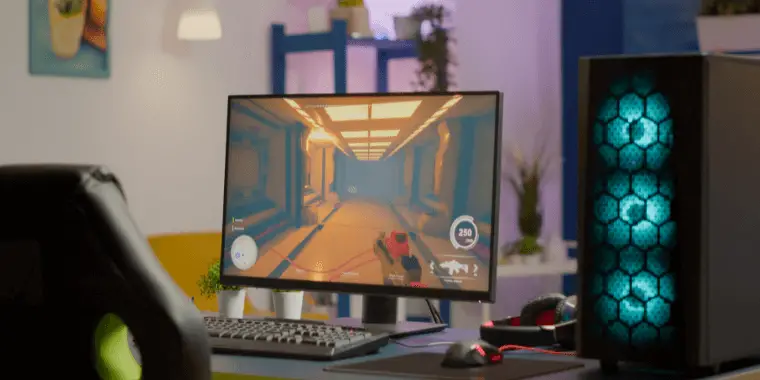
Hey, dear gamers and PC users, it’s a common scenario in which we’re stuck in deciding which type of monitor might suit us best. You might be going through a similar kind of dilemma in which you’re tempted to just guess.
As most of us ponder this never-ending issue of choosing between a gaming monitor vs regular monitor, it’s important to know all the ins and outs of both options. While gamers often crave high frames per second (FPS), regular workers demand a smoother and more balanced working surface.
So, to make it easier for you, we have sorted out all the details of the features of gaming monitors and regular monitors so that you can finally resolve this never-ending dilemma.
Is it Possible to Use a Gaming Monitor as a Regular Monitor?
Gaming monitors are known as high FPS performers. The minimum requirement of a monitor’s FPSis 60 Hz, but a gaming monitor offers 120 Hz (or more), while even the maximum refresh rate gets 200Hz. In comparison, the response time of a gaming monitor is much faster than a regular computer monitor.
Related article: Is 60 Hz good for gaming?
You can use a gaming monitor for multipurpose tasks, such as watching YouTube videos, typing any competitive edge, motion graphics, video editing, and other similar works.
If you’re a regular PC user, you’ll sometimes notice some negative issues while using a gaming monitor. In most cases, a gaming PC setup requires a gaming monitor and demands more power and electricity.
A regular PC monitor may make your experience smoother at this particular stage. The normal monitors will offer you a multimedia monitor, so the color reproduction looks more comfortable to you.
Hence, you’ll need to be careful while using a gaming monitor as a regular monitor. Its material design, 3D visualization system, and high-pixel resolution make it a perfect choice for gaming. At the same time, these features make it a bit inappropriate for regular use.
Is it Possible to Use a Regular Monitor as a Gaming Monitor?
Regular monitors are basically for general purposes such as typing, coding, faster graphics, simple video editing, watching videos, texting, photo editing, and other basic-level work.
Game-playing requires some extra qualities in the monitor. Normally, a regular monitor won’t be able to give you the premium graphics most gamers aim for.
Most regular monitors will ensure you a lower FPS while playing games demands a higher one. Accuracy is another concern that a regular monitor lacks. So, using a regular monitor as a gaming monitor is never a good idea.
Aspects of a Gaming Monitor

A gaming monitor is a must for a gaming PC because of its high resolution, fast clock speed, and high frame rate. Gaming monitors are designed so that they can add maximum value to the graphics card and CPU and can produce an extraordinary game visualization.
Normally, a monitor contains circuitry, a display, an electron gun that mainly draws the output, a power supplying unit, and a button for reconciliation of the screen.
Gaming monitors contain some more components to improve the gaming experience, including a faster electron gun, more pixels, an LCD and LED system, and a curve screen formula.
Nowadays, gaming monitors use material design to develop a 4D visualization system to ensure a realistic vision for the user. This feature adds a bonus to its usage, allowing you to achieve a better experience while gaming.
A gaming monitor is highly accurate; the high number of pixels ensures better coordination of any point, and faster electron guns ensure a higher monitor speed. It also provides pinpoint accuracy and fast speed.
For example, new gamers like to play Fortnite or Minecraft. Convincing resolution, less rendering time, pinpoint accuracy, and speed are mandatory for a gaming monitor, which is the only type of monitor that can fulfill these requirements.
Aspects of a Regular Monitor

A regular monitor contains a normal configuration, a general electron gun, a decent number of pixels, average resolution (maximum 1080 and 1440), and the design system remains in hex vision.
These monitors are also known as multimedia monitors. Simple work like watching videos, typing, generic graphic editing, and web designing can be performed easily with this monitor. It has a particular community of users that consists mostly of office workers and common folks.
The regular workers achieve a comfort level with these monitors since they offer a smooth working experience.
Simultaneously, these monitors provide a well-balanced color display as well, demanding less power than a gaming monitor. Additionally, the users can also work a long time on it even though the refresh rates are not very high. Despite that, regular monitors function satisfactorily when it comes to computer-based work.
Nowadays, regular monitors also contain LED attributes, which adds an extra feature to their regular usage. This all makes regular monitors a more fun device to work with.
Advantages and Disadvantages of a Regular Monitor and Gaming Monitor
You may know that every action has an opposite and similar reaction, and that stands true when it comes to monitors. Since these two types of monitors are crafty in their particular areas, they have some cons as well, some of which are mentioned below.
Advantages of a Regular Monitor

Regular monitors offer a smooth working surface. They are equally beneficial for different types of tasks. Let’s explore the pros of regular monitors:
- They are user-friendly and easy to use.
- They can function with less electricity, making them cost-efficient.
- You can hardly find any fluctuations in the regular monitor’s performance.
- Normal monitors are less harmful to your eyes because they contain a minimal number of gamma rays.
- There are fewer pixels in the regular monitors, so it offers a slower response time.
- If you’re a cost-sensitive person, these monitors can be a good option.
Disadvantages of a Regular Monitor
As we mentioned earlier, every action has an opposite and similar reaction. Therefore, you can face some harsh experiences while using a regular monitor. Let’s uncover the cons:
- Regular monitors contain fewer pixels, which may result in rendering issues.
- The refresh rate is lower, which can be a big issue for a gamer.
- Response times are a bit higher because regular monitors have a lower FPS system.
- The normal monitor can hardly fulfill the gaming experience because of a lower level of accuracy.
- Regular monitors cannot maintain the image quality properly because of the fewer number of pixels.
- It often causes screen tearing while playing a video game.
- You might face situations in which regular monitors are not performing well during any kind of editing because of the slower rendering system.
Advantages of a Gaming Monitor

Gaming monitors are available for a selected community. Demands from gaming monitors are higher as the manufacturers always try to make the monitors upgraded and user-friendly. The reason is quite simple as it has many advantages, including:
- Higher resolution (2160p x4320p)
- Greater accuracy and speed (200 Hz).
- Performance increases with IPS panels.
- Ensures better picture quality because of its large number of pixels.
- More satisfying gaming experience due to their high graphics resolution and FPSsupport system
- Faster response times that increase their demands
- Some gaming monitors offer built-in speakers, which can add to a better gaming experience.
- Curved monitors ensure a 6D gaming experience because you can get a rounded visualization.
- No screen tearing issue with this monitor.
Disadvantages of a Gaming Monitor
You may face some harsh experiences while using a gaming monitor. Let’s explore some of the disadvantages:
- Using an IPS panel is costly.
- Its picture quality may be higher, but it can cause damage to the eyes.
- Gaming monitors provide better resolution, which means they emit more gamma rays.
- Gaming monitors need more power to run.
- A balanced electric power supply is a big issue for these types of monitors.
Gaming Monitor Vs Regular Monitor – the Major Differences
Although both gaming monitors and regular monitors work flawlessly for regular usage, some differences make one better than the other in terms of individual requirements. Some of them are described below:
Differences in Demand
Regular monitors and gaming monitors are different in their configurations and their usage sectors. Both have a particular community of users, and they are different in their aspect ratio as well.
People rate them according to their demands. For example, a professional gamer might opt for a gaming monitor while a regular worker will opt for a standard monitor.
In terms of user demands, the functions of the type of monitor can perform equally well depending on the type of work you want to perform.
Differences in Configuration
The internal configuration of both of these monitors differs. For instance, a gaming monitor offers 120 Hz of FPS while a regular monitor offers 75 Hz of FPS. These make a big difference performance-wise between the two.
Again, the gaming monitors offer high resolution, whereas regular monitors lack a bit in that area. However, general monitors offer a perfect view on the screen, which is ideal for a harsh working schedule.
The variable refresh rate is another difference between the two monitors. Refresh rates of a gaming monitor are considerably higher than that of a regular one. Not to mention, a responsive gaming experience can be achieved while using a gaming monitor as compared to regular monitors.
Differences in Workspace

Professional gamers often join groups to take part in competitive games. Gaming monitors are always available for the gaming zone.
Gamers use these monitors for a higher resolution and better graphics so they can have increased performance while playing these competitive games.
On the other hand, regular monitors are available in the various help centers, BPO companies, KPO companies, studios, and data entry organizations for all kinds of data management work.
Regular monitors are even available in schools and colleges for data entry management. People often choose these monitors for personal use as well.
Many software and IT centers also use this kind of monitor for their work centers. Additionally, these types of monitors are user-friendly with a decent display, too.
When Should You Get a Gaming Monitor?

Now the most important thing to understand is whether you should get a gaming monitor or not. For this purpose, we are going to help you determine when you should get a gaming monitor.
- If you desire to be a professional gamer.
- If you intend to be an editor and work on software, like blender Photoshop or Illustrator.
- A gaming monitor will support you the most in graphic design for its built-in high graphic resolution.
- If your interest is to play complex games and editing videos, a gaming monitor will suffice you with its high FPS resolution and refresh rates.
- A gaming monitor will allow you to perform three different actions simultaneously, like playing games, graphics design, and editing.
- You might opt for a gaming monitor if you want to perform high-graphics video editing and exaggerated VFX.
When Should You Get a Regular Monitor?
Regular monitors are used for multiple purposes by their users. All the general tasks can be performed with it. For a specific view:
- If you are interested in web design only.
- If you perform typing or coding-related jobs.
- You can watch YouTube videos without any problem.
- If you are interested in graphics design.
- You can perform normal video editing tasks without a problem.
- You can perform image processing, data collection, and other general tasks with these monitors.
- If you need an RGB lighting environment.
Frequently Asked Questions
1. Are Gaming Monitors Worth Buying?
Gaming monitors offer a better visualization system that ensures prominent realistic feelings to its users while playing a game. The monitors ensure a high resolution with pinpoint accuracy.
The fast speed of the monitor will impress you, so the material design of the monitor will offer you a better experience in the game. You can even play virtual reality games on high spec monitors.
So, if you are a professional gamer or intend to be a gamer, opt for a gaming monitor. Without a gaming monitor, the gaming experience will prove unpleasant to you.
2. What Makes a Monitor Worth it?
Monitors are the output of your work. In modern times, monitors are upgraded frequently, and the expectations are increasing daily.
Manufacturers keep upgrading the elements to fulfill the demands of their consumers. At the current time, a monitor has qualities that make it valuable, including the following:
- Decent resolution
- Convincing refresh rate
- Smooth rendering
- Decent FPS speed
- Proper pixel management
- Balanced multimedia monitors
- A sufficient number of options for customization
- User-friendly display
- Good electricity management system
3. Can I Use a Gaming Monitor as a TV?
Gaming monitors provide more graphical configurations like high picture quality and high resolution, along with a fast-rendering system.
Therefore, you can use a gaming monitor as a TV. You will find yourself more comfortable while watching sports, HD quality movies, and animation.

4. Does Refresh Rate Matter for Streaming?
For game streaming, refresh rate is a crucial concern because streaming-related software requires a certain amount of FPS. Refresh rates play a big role primarily in entering a good gaming server and streaming different high graphics games.
If you want to stream from television, then the refresh rate doesn’t matter. Just make sure your monitor ensures 60 Hz of FPS, which is common for today’s gaming requirements. But, if you want to broadcast from your television, then you have to ensure a higher FPS.
Final Words
Monitors are one kind of output-relevant device. Whether it’s your passion to make advances in VFX or just have a smoother working experience, it’s crucial to sort out the type of monitor. After all, you’ll always enjoy a better experience when the device meets your demands.
As the monitor is an electronic device with two different categories, to guide you through, we’ve covered everything you need to know about gaming monitor vs regular monitor. So, now you can get a clear sense of which one suits your requirements best.